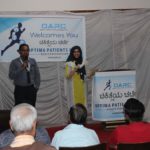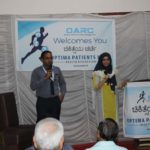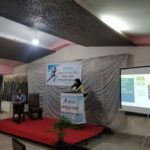ARTHRITIS AND JOINT PAIN
Arthritis, or inflammation (pain with swelling) of the joints, is the most common extraintestinal complication of IBD. It may affect as many as 30% of people with Crohn’s disease or ulcerative colitis. Although arthritis is typically associated with advancing age, in IBD it often strikes younger patients as well. In addition to joint pain, arthritis also causes swelling of the joints and a reduction in flexibility.
It is important to point out that people with arthritis may experience arthralgia, but many people with arthralgia may not have arthritis.
Types of Arthritis
- Peripheral Arthritis. Peripheral arthritis usually affects the large joints of the arms and legs, including the elbows,wrists, knees, and ankles. The discomfort may be “migratory,” moving from one joint to another. If left untreated, the pain may last from a few days to several weeks. Peripheral arthritis tends to be more common among people who have ulcerative colitis or Crohn’s disease of the colon. The level of inflammation in the joints generally mirrors the extent of inflammation in the colon. Although no specific test can make an absolute diagnosis, various diagnostic methods—including analysis of joint fluid, blood tests, and X-rays—are used to rule out other causes of joint pain. Fortunately, IBD-related peripheral arthritis usually does not cause any lasting damage and treatment of the underlying IBD typically results in improvement in the joint discomfort.
- Axial Arthritis. Also known as spondylitis or spondyloarthropathy, axial arthritis produces pain and stiffness in thelower spine and sacroiliac joints (at the bottom of the back). Interestingly, and especially in young people, these symptoms may come on months or even years before the symptoms of IBD appear. Unlike peripheral arthritis, axial arthritis may cause permanent damage if the bones of the vertebral column fuse together—thereby creating decreased range of motion in the back. In some cases, a restriction in rib motion may make it difficult for people to take deep breaths. Active spondylitis generally subsides by age 40. Therapy for people with axial arthritis often includes the use of biologic therapies. Non-medical therapies are geared toward improving range of motion in the back. Stretching exercises are recommended, as is the application of moist heat to the back. Treatment of the underlying IBD is helpful, but generally less effective than in patients with peripheral arthritis.
- Ankylosing Spondylitis. A more severe form of spinal arthritis, ankylosing spondylitis (AS) is a rare complication,affecting between 2% and 3% of people with IBD. It is seen more often in Crohn’s disease than in ulcerative colitis. In addition to causing arthritis of the spine and sacroiliac joints, ankylosing spondylitis can cause inflammation of the eyes, lungs, and heart valves. The cause of AS is not known, but most affected individuals share a common genetic marker. In some cases, the disease occurs in genetically susceptible people after exposure to bowel or urinary tract infections. Occasionally, AS foretells the development of IBD. AS typically strikes people under the age of 30, mainly adolescents and young adult males, appearing first as a dramatic loss of flexibility in the lower spine. Rehabilitation therapy is essential to help maintain joint flexibility. But even with optimal therapy, some people will develop a stiff or “ankylosed” spine. Symptoms of AS may continue to worsen even after surgical removal of the colon. It is important to see a rheumatologist when this disease is suspected, as biologic treatments often help reduce complications and joint damage.
Diagnosis
It is not always easy to determine if the arthritis is linked to the intestinal condition. In general, the arthritis that complicates IBD is not as severe as rheumatoid arthritis. The joints do not ordinarily undergo destructive changes, and joint involvement is not symmetric (affecting the same joints on both sides of the body). Except for ankylosing spondylitis, arthritis associated with IBD usually improves as intestinal symptoms improve.
Treatment
In the general population, people with peripheral arthritis may use nonsteroidal anti-inflammatory drugs (NSAIDs) to reduce pain and swelling of the joints. However, as a rule, these medications—which include aspirin and ibuprofen—are not a good option for everyone with IBD because they can irritate the intestinal lining and increase the inflammation. (It should be noted, though, that some people with IBD can tolerate NSAIDs and find these medications helpful in relieving symptoms of arthritis. It is important to discuss medication usage with your doctor.) Corticosteroids also may be used to treat the arthritis symptoms as well as IBD.
In most cases, doctors manage the symptoms of peripheral arthritis by controlling the inflammation within the colon. Only axial arthritis seems not to improve as the intestinal inflammation resolves. Once inflammation has decreased, possibly after a course of a medication such as prednisone or sulfasalazine (or other 5-aminosalicylates), joint pain generally disappears. Because they take months to work, the immunomodulators azathioprine and/or 6-mercaptopurine are not used specifically to control joint inflammation. However, the immunomodulator methotrexate can be an effective treatment for IBD-associated joint pain. Similarly, the newer biologic agents such as infliximab (Remicade®), adalimumab (Humira®), and certolizumab (Cimzia®) have all been shown to be very effective in reducing joint inflammation and swelling. Infliximab and adalimumab have even shown good results as a primary treatment for ankylosing spondylitis, preventing joint damage and destruction.
In addition to medication, doctors may recommend resting the affected joint, occasional use of moist heat, or range of motion exercises, as demonstrated by a physical therapist.













